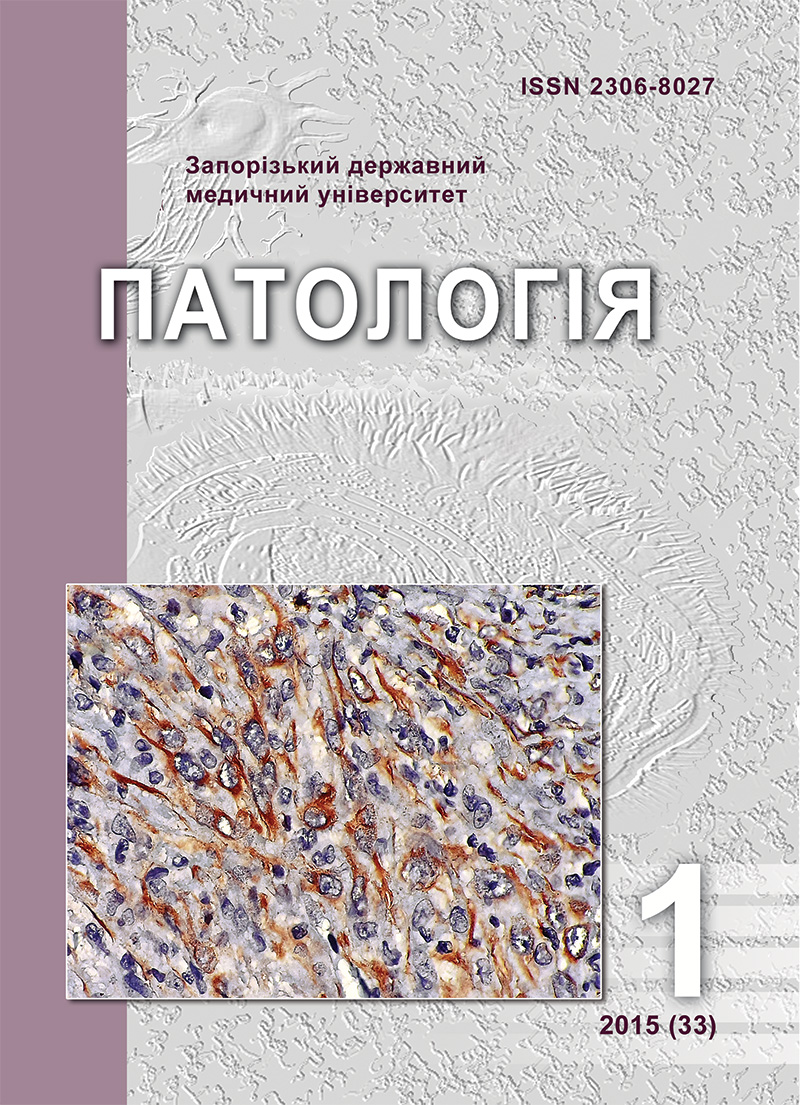Morphological state of aorta in the fetuses and newborns suffered from chronic intrauterine hypoxia (experimental research)
DOI:
https://doi.org/10.14739/2310-1237.2015.1.42818Keywords:
Hypoxia, Pregnancy, Aorta, Animal ExperimentationAbstract
The cardiovascular system in newborns with chronic hypoxia is affected in 40–70%.
Aim. To investigate morphological state of aorta in the fetuses and newborns suffered from chronic intrauterine hypoxia.
Methods and results. Aortic wall was investigated with modern morphological methods in 34 laboratory animals in order to identify the morphological features of the fetuses and newborns’ vessel affected by this pathogenic factor. It was established that chronic hypoxia leads to endothelial trophics deterioration, its flattening, dystrophic processes with following cells desquamation, density reduction of smooth muscle cells, thickening of the intima-media.
Conclusion. It shows alterative-sclerotic changes in aorta in cases with chronic hypoxia influence.
References
Karpova, I. Yu., Parshikov, V. V., Mironov, А. А., Kochkurova, Е. V., Stulova, E. S., Novikova, Ya. S. (2011). Izuchenie vliyaniya khronicheskoj vnutriutrobnoj gipoksii na techenie beremennosti i razvitie potomstva v e`ksperimente [The study of chronic intrauterine hypoxia effect on pregnancy course and development of the offspring in the experiment]. Medicinskij al`manakh, 6(19), 55–57. [in Russian].
Shejbak, L. N. (2008). Vliyanie faktora gipoksii na serdce novorozhdennogo [Hypoxia factor influence on the newborn’s heart]. Medicinskie novosti, 2, 18–22. [in Belarus].
Thompson, J. A., Richardson, B. S., Gagnon, R., Regnault, T. R. (2011). Chronic intrauterine hypoxia interferes with aortic development in the late gestation ovine fetus. Journal of Physiology, 589(13), 3319–32. doi:10.1113/jphysiol.2011.210625.
Giussani, D. A., Camm, E. J., Niu, Y., Richter, H. G., Blanco, C. E., Gottschalk, R., et al. (2012). Developmental programming of cardiovascular dysfunction by prenatal hypoxia and oxidative stress. PLoS ONE, 7(2), e31017. doi:10.1371/journal.pone.0031017.
Gambaryan, P. P., & Dukel`skaya, N. M. (1955). Krysa [Rat]. Moscow: Sovetskaya nauka. [in Russian].
Liliensiek, S. J., Nealey, P., & Murphy, C. J. (2009). Characterization of endothelial basement membrane nanotopography in rhesus macaque as a guide for vessel tissue engineering. TISSUE ENGINEERING, 9(15), 2643–2651. doi: 10.1089/ten.TEA.2008.0284.
Falanga, V., Zhou, L., T. (2002). Low oxygen tension stimulates collagen synthesis and COL1A1 transcription through the action of TGF-beta1. Journal of Cellular Physiology, 191(1), 42–50. doi: 10.1002/jcp.10065.
Zamechnik, T. V., & Rogova, L. N. (2012). Gipoksiya kak puskovoj faktor razvitiya e`ndotelial'noj disfunkcii i vospaleniya sosudistoj stenki (obzor literatury) [Hypoxia as starting factor of development of endothelial dysfunction and inflammation of the vascular wall (Literature review]. Vestnik novykh medicinskikh technologij, 2(19), 393–394. [in Russian].
Kamoeva, S. V. (2013). Fermentnye i geneticheskie aspekty patogeneza prolapsa tazovykh organov i disfunkcii tazovogo dna u zhenschin [The pathogenesis of pelvic organ prolapse and pelvic floor dysfunction in women: Enzyme and genetic aspects]. Rossiiskij vestnik akushera-ginekologa, 3, 31–35. [in Russian].
Poberezhnik, H. A., & Omel`chenko, O. A. (2013). Morfologicheskie izmeneniya slizistoj obolochki gajmarovoj pazukhi v zavisimosti ot prichiny verkhnechelyustnogo sinusita [Morphological changes in the maxillary sinus mucosa depending on the cause of the maxillary sinusitis]. Ekolohichni problemy eksperymentalnoi ta klinichnoi medytsyny, 1, 325–338. [in Ukrainian].
Downloads
How to Cite
Issue
Section
License
Authors who publish with this journal agree to the following terms:- Authors retain copyright and grant the journal right of first publication with the work simultaneously licensed under a Creative Commons Attribution License that allows others to share the work with an acknowledgement of the work's authorship and initial publication in this journal.

- Authors are able to enter into separate, additional contractual arrangements for the non-exclusive distribution of the journal's published version of the work (e.g., post it to an institutional repository or publish it in a book), with an acknowledgement of its initial publication in this journal.
- Authors are permitted and encouraged to post their work online (e.g., in institutional repositories or on their website) prior to and during the submission process, as it can lead to productive exchanges, as well as earlier and greater citation of published work (SeeThe Effect of Open Access).

